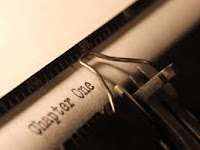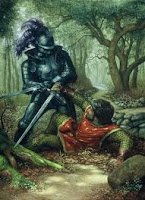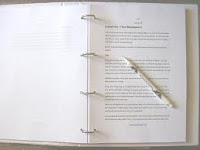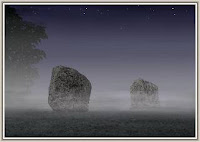I read an article by
Jordan E. Rosenfeld on Writer’s Digest about beginning new scenes.
If you prefer not going to article, I’ve pasted most of it here in his own words.
A story is made up of a progression of scenes that are glued together with narrative. The scenes progress the story and takes us from beginning through to the end. Each new scene must move the story along and keep the reader engaged and, well, reading. To do that, every scene must have a purpose and must recapture your reader’s attention.
To deliver to their readers, writers should ask themselves these two questions when beginning a scene:
- Where are my characters in the plot?
- Where did I leave them and what are they doing now?
What is the most important piece of information that needs to be revealed in this scene?
There are three ways to begin a scene: Action, Narrative, and Setting
ACTION
Time and momentum are critical in the action scene. To build the momentum the action must start quickly and must show (not tell) the reader what is happening without any explanation
Action launches tend to energize the reader’s physical senses. To create an action launch:
1. GET STRAIGHT TO THE ACTION. Don’t drag your feet here. “Jimmy jumped off the cliff” rather than “Jimmy stared at the water, imagining how cold it would feel when he jumped.”
2. HOOK THE READER WITH BIG OR SURPRISING ACTIONS. An outburst, car crash, violent heart attack or public fight at the launch of a scene allows for more possibilities within it.
3. BE SURE THAT THE ACTION IS TRUE TO YOUR CHARACTER. Don’t have a shy character choose to become suddenly uninhibited at the launch of a scene. Do have a bossy character belittle another character in a way that creates conflict.
4. ACT FIRST, THINK LATER. If a character is going to think in your action opening, let the action come first, as in, “Elizabeth slapped the Prince. When his face turned pink, horror filled her. What have I done? she thought.”
NARRATIVE
Narrative summaries such as backstory or upcoming action distract and interrupt the reader. It can take the reader out of the story. However, it can be effective if it’s not too long.
A narrative approach is best used with the following strategies:
5. SAVE TIME BY BEGINNING WITH SUMMARY. Sometimes actions will simply take up more time and space in the scene than you would like. A scene beginning needs to move fairly quickly and, on occasion, summary will get the reader there faster.
6. COMMUNICATE NECESSARY INFORMATION TO THE READER BEFORE THE ACTION KICKS IN. Sometimes information needs to be imparted simply in order to set action in motion later in the scene. Opening sentences such as, “My mother was dead before I arrived,” “The war had begun” and, “The storm left half of the city underwater,” could easily lead to action.
7. REVEAL A CHARACTER’S THOUGHTS OR INTENTIONS THAT CANNOT BE SHOWN THROUGH ACTION. Coma victims, elderly characters, small children and other characters sometimes cannot speak or act for physical, mental or emotional reasons; therefore the scene may need to launch with narration to let the reader know what they think and feel.
SETTING
To me, setting is a dramatic tool and is as important as one of the characters in a story. It sets the mood and gives the reader a place ‘to be.’ Where you place that description can add to the drama.
Using setting can be effective in the following instances:
8. ENGAGE WITH SPECIFIC VISUAL DETAILS. If your character is deserted on an island, the reader needs to know the lay of the land. Any fruit trees in sight? What color sand? Are there rocks, shelter or wild, roaming beasts?
9. USE SCENERY TO SET THE TONE OF THE SCENE. Say your scene opens in a jungle where your character is going to face danger; you can describe the scenery in language that conveys darkness, fear and mystery.
10. REFLECT A CHARACTER’S FEELINGS THROUGH SETTING. Say you have a sad character walking through a residential neighborhood. The descriptions of the homes can reflect that sadness—houses can be in disrepair, with rotting wood and untended yards. You can use weather in the same way. A bright, powerfully sunny day can reflect a mood of great cheer in a character.
Scene launches happen so quickly and are so soon forgotten that it’s easy to rush through them, figuring it doesn’t really matter how you get it started. Don’t fall prey to that thinking. Take your time with each scene launch. Craft it as carefully and strategically as you would any other aspect of your scene. Remember that a scene launch is an invitation to the reader, beckoning him to come further along with you. Make your invitation as alluring as possible. ~ Jordan E. Rosenfeld
How do you decide how to start a scene? Do you have a favorite style?
ANNOUNCEMENT: December 16 I’ll be participating in the week-long Mistletoe Madness Blog Hop. I hope you join in for reading fun and giveaways. The grand prize is a Nook pre-loaded with books by participating authors.





Ruth – Good advice. I'm currently reading Anatomy of a Story by John Truby. Extremely useful in building the story before even writing the first sentence. I'm learning that all the background work is the foundation for an action scene. Then your tips are applied.
Thanks Ruth for the great topic. I always enjoy your blogs. I always struggle with scene openings. I love the 10 item format, defining my options helps me clarify the direction I want to take.
Stephanie Rankin
@Stephanie Rankin
I'm a list person. Give me a list I can tick off and show progress and I'm a happy person.
I'm glad you enjoy my posts.
… Ruth
@Jeanine
Preparation is the key. This past month I took April Kihlstrom's Book in a Week class. Here suggestions on understanding your story and characters were fantastic.
I haven't read John Truby's book but will certainly look into it. Thanks for the recommendation.
… Ruth
Lots of solid advice here! I'm bookmarking it as a reminder for later!
@Margay
I'm glad you found it helpful.
… Ruth
No matter where one is on the rocky road of publication, always good to remember and incorporate these into one's writing. I know I will. Thanks for posting these important basics!
@Tanya Goodwin
Hi Tanya!
I get the first draft down then go back to make certain the scenes flow and that I vary how they start. Sometimes when the scene doesn't seem to go right, changing how it starts makes all the difference.
… Ruth
I did! Thank you.
Another terrific and helpful post.
I can never be reminded too much in ways to improve a scene.
It's what makes for a great book.
Thank you!
@Sandy L. Rowland
Hi Sandy –
I know about reminders. I have such 'aha' moments when I read them.
I'm glad you enjoyed the post.
… Ruth
SOme good reminders here, thanks for sharing!
@Elizabeth Staab
I'm glad you found it helpful.
… Ruth
Good solid advice. Having worked with authors at all levels of experience, it is surprising how often bringing a scene intro in line with your suggestions makes a dramatic improvement. It is even more important when the scene begins a chapter. Thanks for sharing. Helen
___________________________________
Helen Henderson http://www.helenhenderson-author.webs.com
Stories that take you to the stars, the Old West, or worlds of imagination
Windmaster– Revenge set Ellspeth and the archmage, Dal, on the path to her destiny, but prophecy controlled the journey. Paperback and ebook: Burst Books, Amazon.com. Ebook only: AllRomance/Omnilit, Barnes and Noble. Coming in 2012 – Windmaster Legacy and Dragon Destiny.
@Helen Henderson
When I write, I need to get the story out of my head and 'on paper.' When I read it out loud I begin to fine tune and change things up.
Thanks for leaving a comment.
… Ruth
Loved the list. I'd add if the novel is dark starting with an intense description of the location works well and tells the reader this is a dark book, one of the reasons I love a good Gothic Romance. The hook is usually a description which gives the reader a creepy feeling.
Very nice. Great advice. I'll need to bookmark this one.
An excellent post. I love the part "Remember that a scene launch is an invitation to the reader, beckoning him to come further along with you." And it's so true.
Janice~
Hi Ruth, Thanks for sharing this. My favorite scene starter is using setting and weather to create the mood for a scene.
Great stuff, Ruth! Thanks.